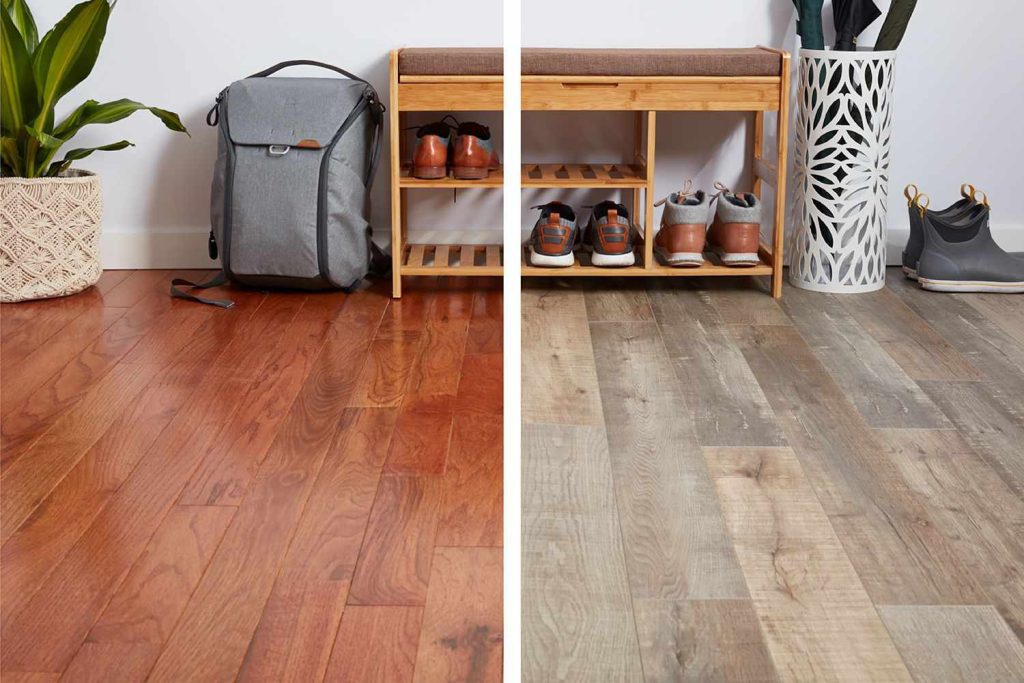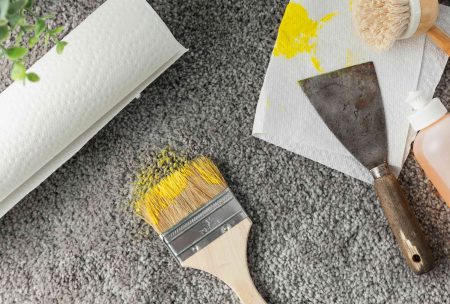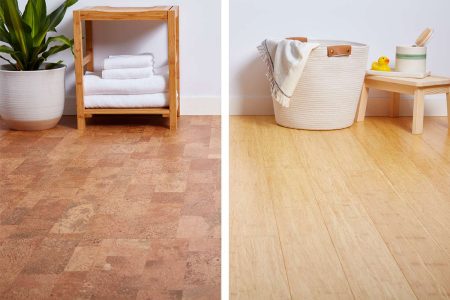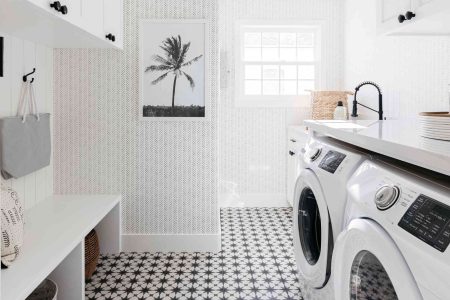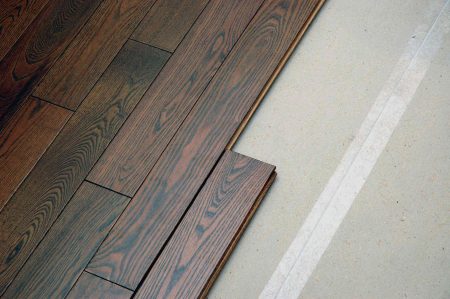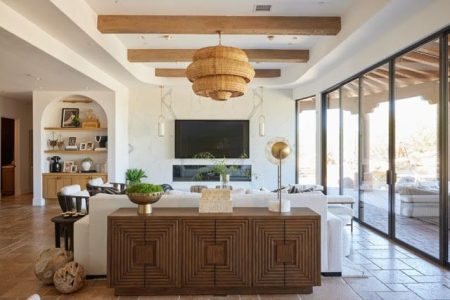Solid hardwood flooring is often regarded as the real deal, with laminate flooring occupying the next rung down as an inexpensive way to simulate the look of real hardwood flooring. Hardwood flooring—3/4-inch-thick boards of solid hardwood cut from a tree—is undoubtedly a quality material. But this does not mean that you should automatically discount laminate flooring. Solid hardwood floor and laminate flooring each have their own place, with their own unique set of values as well as challenges.
Solid Hardwood vs. Laminate Flooring: Major Similarities
The main similarity—and arguably the only similarity—between solid hardwood flooring and laminate flooring is that both look like wood.
Even that similarity comes with its own difference: Both materials look like wood when viewed from a distance. Solid hardwood looks like wood at any distance, far or near. But laminate flooring’s wood-like appearance degrades the closer you view it.
Hardwood and laminate flooring have only a few other, minor similarities: both are hard and both are fairly durable. But solid hardwood and laminate flooring are more different than they are alike.
Solid Hardwood vs. Laminate Flooring: Major Differences
Solid hardwood flooring is comprised of flooring boards that are solid hardwood material through and through. The boards, usually 3/4-inch thick, are milled with a smooth top surface and tongue-and-groove edges that interlock to hold the boards together. Floorboards are installed by nailing the boards to the subfloor through the tongues along the edges of the boards. If the boards are unfinished, the floor is stained and varnished once the installation is complete. However, prefinished solid hardwood flooring is a more common option.
Laminate flooring is manufactured by starting with a core layer of fiberboard made of wood byproducts. Over this is a design layer that is printed to resemble wood or other material. The design layer is protected by a clear wear layer that offers good resistance to scratching and stains. Laminate flooring boards are relatively thin, 6 to 12 mm (1/4- to 1/2-inch) thick, and are manufactured with click-lock edges that snap together to secure the boards. This is a floating floor that requires no nailing or glue.
Watch Now: Laminate vs. Solid Hardwood Floor
Appearance
Solid Hardwood
Solid hardwood flooring is a highly attractive, premium building material that has undeniable prestige. Even cheaper species of real hardwood (red or white oak) are usually more attractive than laminate’s artificial premium species.
Laminate
From a distance, quality laminate flooring can look much like real wood. But at close inspection, it is easy to see that laminate flooring is not real hardwood. Also, laminate boards repeat patterns, so care must be taken to mix up the boards on installation.
Newer, top-quality laminates now have a more random repeat pattern and they integrate a surface grain texture to make the flooring even more realistic. Still, the wood look is less than perfect.
Best for Appearance: Solid Hardwood
While both solid hardwood flooring and laminate flooring are attractive and look like wood from a distance, only solid hardwood flooring looks like wood close-up. Not only that but solid hardwood does not have boards that repeat patterns.
Get expert flooring help from a pro
We can’t all be experts. Find and compare quotes from top-rated professionals near you.
Get a Quote
Water and Heat Resistance
Solid Hardwood
Although popular in kitchens, solid hardwood is not recommended for wet areas, either. Solid hardwood flooring can be damaged by standing water and floods. You can install hardwood flooring over radiant heating systems, but be aware that heating the wood can cause the boards to shrink and the joints to open up.
Laminate
Laminate surfaces are highly water- and stain-resistant. But water infiltrating the joints between planks can cause the edges and the fiberboard core to swell and chip. It is not recommended in wet areas, such as bathrooms. Laminate flooring has enough heat resistance that it can be installed over radiant heating systems.
Best for Water and Heat Resistance: Laminate
Neither laminate nor solid hardwood flooring are ideal flooring materials for truly wet locations. Laminate flooring is marginally better for humid locations, such as installation against concrete slabs. Laminate flooring also has some advantages over hardwood when it comes to heat resistance.
Care and Cleaning
Solid Hardwood
Cleaning of a solid hardwood floor is simple: sweeping or vacuuming, and damp-mopping with a wood cleaner. Today’s wood floors mostly come pre-finished, so they never need to be polished or waxed.
Laminate
Laminate floors are easily cleaned with a vacuum or broom. Mopping should be done with a damp mop moistened with a laminate floor cleaner. No waxing is ever necessary. Avoid excessive water and never clean with a steam cleaner.
Best for Care and Cleaning: Tie
Both solid hardwood and laminate flooring are easy to care for.
Durability and Maintenance
Solid Hardwood
Hardwood flooring can last a lifetime—or even longer. Unusual circumstances, though, like flooding, can render a hardwood floor worthless if the water isn’t mopped up fast enough. Hardwood likely will need to be recoated or refinished periodically, depending on wear and care. Periodic resealing is recommended, and when the damage becomes severe, the floor can be sanded down and refinished. This should be done by professionals since there are a limited number of times a hardwood floor can be resanded. Most floors wear down after three or four sandings, so use discretion when choosing this method.
Laminate
Laminate flooring has moderately good resistance to damage from impact. If an object is heavy enough and hits laminate with sufficient force, the floor will be gouged or dented. Expect 10 to 15 years of use, maximum. Hazards that shorten the lifespan of laminate include water infiltration, scratches from chair legs, and even UV rays.
Laminate flooring cannot be refinished or sanded. When laminate flooring is ruined, boards can be replaced individually.
Best for Durability and Maintenance: Solid Hardwood
Hardwood floors come out well on top when it comes to durability. Hardwood and laminate are roughly equal when it comes to maintenance.
Installation
Solid Hardwood
Solid hardwood is difficult for non-professionals to install. Rental of special tools such as a floor nailer or stapler is required. Unfinished flooring must be sanded and finished after the planks are installed; the sanding and finishing is a job for professionals. Prefinished hardwood flooring does not need to be finished after it is installed.
Laminate
Laminate flooring is very easy to install, making it a favorite for DIYers. The planks click together at the edges, and there is no need for fasteners or glue since this is a flooring that floats over a thin layer of foam underlayment. While laminate flooring can be installed below grade, it is still not the best flooring for basements.
Best for Installation: Laminate
Laminate flooring has a clear advantage over solid hardwood with installation. Laminate is far easier for do-it-yourselfers to install than solid hardwood flooring. Laminate installation is within the realm of possibility for even inexperienced DIYers. Solid hardwood requires more tools and experience to install.
Cost
Solid Hardwood
Solid hardwood flooring costs from $4 to 8 per square foot for common hardwoods like oak, maple, and ash, with more unique species commanding higher prices. Solid hardwood flooring costs $14 to $32 per square foot, materials plus installation.
Laminate
Laminate flooring typically costs $1 to $3 per square foot. Designer laminate flooring selling for as much as $10 to $12 per square foot is also available. Thicker wear layers are what distinguish the better, more expensive products.
Best for Cost: Laminate
Laminate flooring can be purchased for a fraction of the cost of solid hardwood flooring. The savings become even greater if you install the flooring yourself.
Lifespan
Solid Hardwood
Solid hardwood floors can can last 50 or even 100 years with proper care and refinishing.
Laminate
Laminate floors average about 15 to 25 years of life.
Best for Lifespan: Solid Hardwood
Laminate floors have a considerably shorter life than solid hardwood flooring. Solid hardwood floors can be refinished several times before needing to be replaced. Hardwood floors can last from four to six times longer than laminate floors.
Sizes
Solid Hardwood
Solid hardwood flooring is typically sold in 1 1/2-inch or 2 1/4-inch-wide boards that are 48 inches long, though wide-plank forms up to 6 inches wide or more are also available. The boards are almost always 3/4 inch thick.
Laminate
Laminate flooring generally comes in planks 4 inches wide or more and about 48 inches long. The thickness of the planks ranges from 6 to 12 mm, depending on the quality of the product.
Best for Sizes: Solid Hardwood
There is no advantage to the length and width sizing standards of one flooring over the other. But solid hardwood’s thickness is an advantage because it can bridge subflooring imperfections and provide a solid base underfoot.
Resale Value
Solid Hardwood
Hardwood flooring tends to have good resale value if it is in decent shape. Solid hardwood ranks with high-quality porcelain or natural stone tile as a premium flooring material. Some estimates place solid hardwood flooring’s ROI (return on investment) to be as high as 70- to 80-percent.
Laminate
Laminate flooring adds less real estate value to a home than solid hardwood. Laminate flooring is considered to be a good addition to a low- or mid-range priced house, though.
Best for Resale Value: Solid Hardwood
Hardwood floors will always impress real estate professionals and potential buyers, provided the floor is well cared for.
Comfort and Sound
Solid Hardwood
Hardwood floors tend to hold true to their name: they are hard underfoot. Radiant heating systems can be installed under solid hardwood flooring. But the need for auxiliary heat is less than with laminate flooring because it naturally feels warmer.
Laminate
Laminate flooring is generally somewhat soft underfoot since it is installed over a foam underlayment. But as a floating floor, it can sometimes flex underfoot unless the subfloor is perfectly flat.
The hard plastic wear layer can transmit the clicks of shoe heels and pet toenails. Laminate flooring can be installed over radiant heating systems to create a warmer, cozier floor.
Best for Comfort and Sound: Laminate
Both flooring materials have roughly the same surface characteristics. Laminate flooring is somewhat more comfortable due to the softening characteristics of its underlayment.
The Verdict
If authenticity, resale value, and durability are what is most important, then choose solid hardwood flooring. But laminate flooring can be a viable option where your budget is limited or where you want to install the flooring yourself. Laminate flooring will never pass for real hardwood to the discerning eye, but it can be a serviceable flooring for many situations.
If your goal is to add long-term value to your home, solid hardwood flooring is the best investment.
Top Brands
Several national brands offer both laminate flooring and solid hardwood:
- Bruce, once owned by Armstrong, is now owned by AIP (American Industrial Partners). The company offers laminate flooring as well as solid and engineered hardwood. Its products are widely available at home improvement centers.
- Shaw Flooring Shaw Flooring offers many flooring projects, ranging from bargain laminates to quite expensive solid hardwoods. Its products are sold mostly at specialty flooring stores. Its laminate flooring is sold principally at big-box home improvement centers.
- Mohawk: This company offers both solid hardwood and engineered hardwood (called TecWood), as well as a broad selection of wood-look laminates, which is marketed as RevWood.
-
What lasts longer: hardwood or laminate?
Hardwood floors typically last much longer than laminate, though they do need occasional refinishing. It’s also usually easier to repair a hardwood floor, often with some sanding and staining, whereas damaged laminate might need to be replaced altogether.
-
What costs more: hardwood or laminate?
Hardwood flooring almost always costs more to install than laminate. But depending on how long you live in your home, you might save money in the long run because hardwoods have a much longer lifespan.
-
Can you tell the difference between laminate and hardwood?
Laminate flooring has a repeating pattern whereas hardwood boards are unique. Thus, it is possible to spot a laminate floor due to its pattern. But high-end laminates have been crafted to mimic the random quality of real wood, so it sometimes can be difficult to tell the difference.
Read the full article here



